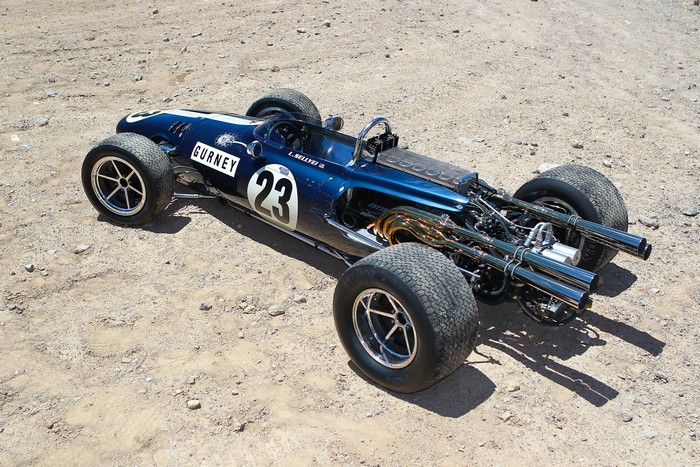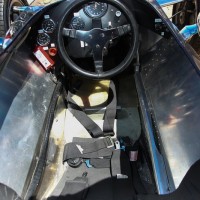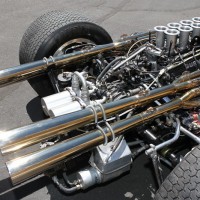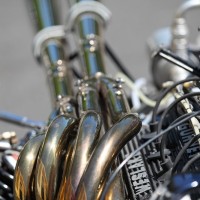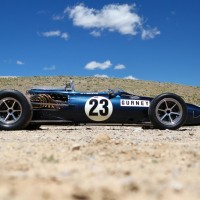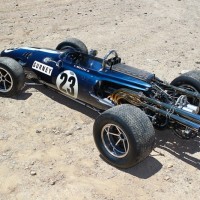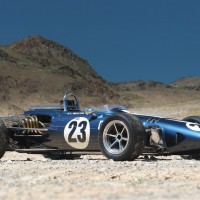Despite his success in almost every category of international motor racing, many consider Dan Gurney’s incomparable Eagle race cars to be his moAst significant contribution to American motorsports.
Designed and built in Southern California, the original Gurney-Weslake Eagles raced with success on the world’s stage and were among the most memorable machines built during the golden age of Formula One, before the purity of Grand Prix cars was forever tarnished with aerodynamic aids and corporate sponsorship.
Driven by some of the best drivers of the era — including Gurney, Phil Hill, Richie Ginther, Bob Bondurant and Bruce McLaren — the Mk I Eagles were everything that an American-made Grand Prix car should be: incredibly fast, impeccably finished, and uncompromisingly individual. Widely regarded as the most beautiful Formula One car ever built, the Eagle Mk I is a prime example of automotive artistry, from its magnificent beak nose to its gleaming coils of polished exhaust pipes.
The Eagle Mk I presented here competed in two World Championship seasons, raced at seven major events and helped Dan Gurney capture one of his six Grand Prix wins. AAR-102 begs no excuse whatsoever regarding beauty, condition, authenticity, or provenance.
SCM Analysis
Detailing
| Vehicle: | 1966 Gurney-Weslake Eagle Mk 1 |
| Number Produced: | Four (three V12, one Climax 4-cylinder car) |
| Original List Price: | N/A |
| Club Info: | Historic Grand Prix |
| Website: | http://www.historicgrandprix.com |
This car, Lot 119, sold for $3,740,000, including buyer’s premium, at the Gooding & Company Pebble Beach auction on August 18, 2013.
Vintage Formula One cars are an extremely specialized subset of the old racing and collector-car market. Because they are not useable except on the track as pur sang racers, they seldom carry anywhere near the value of the sports and GT cars of similar eras. Being able to — at least hypothetically — maintain a car yourself and take your spouse on a tour or to a car show generally means that two-seat racers are worth two to three times as much as a single seater.
There are, obviously, exceptions to this rule, including the Mercedes W-196 I wrote about last month (October 2013, p. 54), and the subject of this story: the Gurney Eagle Formula One.
Formula One history
It is probably best to start with a quick primer on post-war Formula One race cars, as they fit into a distinct set of groups in their characteristics, the experience they offer and their collectibility.
The earliest period, through 1954, was for 1.5-liter supercharged or 4.5-liter normally aspirated cars. The ultimately collectible and hens-tooth-rare Type 158 “Alfetta” Alfa Romeos were dominant, but the era is best represented by 4.5-liter Talbot Lagos, which are big, roomy, heavy cars with huge tires and not much brake. They are easy to maintain and fun to drive — but only modestly collectible.
The second period started in 1954, and specified 2.5-liter, non-supercharged engines. Mercedes-Benz’s W-196 racers ruled the first few years of this era, but Mercedes withdrew at the end of 1955, leaving the field to what are generally known as the late 1950s Formula One cars. The Maserati 250F is probably the best-known example, although Ferrari, BRM, Vanwall, and Cooper (among others) produced excellent examples.
These cars were created in a period when grace and beauty trumped aerodynamics as design criteria, frames were tubular and bodies were aluminum. So, these cars are very pretty and tend to be rather large and commodious inside. They are great fun to drive, due to an excellent balance of power to traction, and they are mechanically relatively easy to maintain. As a result, they are equally at home in great collections and on the track.
Formula One through this entire time was wildly dangerous, and in an attempt to cut down the speeds — and thus increase safety — a 1.5-liter, non-supercharged formula was established for the period 1961 through 1965. The resulting lack of horsepower combined with a rapidly evolving technology created tiny, aerodynamically optimized missiles with every possible ounce of weight shaved away.
The first ones used tubular frames and 4-cylinder engines, but they were quickly made obsolete by the introduction of Climax and BRM V8s and the Monocoque chassis designs. All of the bodies were fiberglass. The cars of this era are generally not very collectible and are challenging to use as a pure racer. Most American drivers can’t fit inside one. There are also fragile, expensive to maintain, difficult to drive well, and every bit as deadly as the ones that came before.
1966 saw the beginning of the modern era of Formula One, with the new formula specifying 3-liter, normally aspirated engines. Although the concept lasted until 1977, it is useful to divide the cars into two groups: the early cars and the DFV-era ones. At the start of the 3-liter formula, you could almost hear the sighs of relief among the designers — weight and drag suddenly weren’t that important because they now had horsepower to work with.
The resulting cars were substantially larger and thus more comfortable to drive. The modern racing tire had been introduced in 1965, and by 1966 tires were getting wider almost by the month, so traction and getting the power down were far less of a problem.
However, finding suitable power was a very big problem, as nobody had adequately anticipated the change. Climax quit the business, BRM tried stacking two flat-8, 1.5-liter engines to make an H16 before settling back to a V12, REPCO used an Oldsmobile 215 block to create a racing V8, Ferrari used its venerable 250 V12 and, of course, Dan Gurney created a V12 for his Eagle.
It was a time of tremendous experimentation and innovation as everybody tried to figure out what worked, with the result being very interesting — if not always very successful — cars that are highly collectible. They are also the first of the F1 cars for which safety became a serious consideration, which is not a small issue if you want to actually drive one.
In 1967, Lotus found “the answer” with its dominant Lotus 49 and the Cosworth DFV engine, and by 1969, Formula One had entered the DFV era. For the next nine years, a monocoque chassis with a DFV was all but required to be a successful entrant. Only BRM, Matra and Ferrari built their own engines. The other big changes were unlimited sponsorship, which made the cars into rolling billboards, and wings, which immediately made any earlier car obsolete.
This era continued with constant evolution until the next paradigm shift in 1978, when Lotus introduced ground effects and Renault introduced its 1.5-liter turbocharged engine, at which point everything changed forever.
I will call the cars of the 1969–77 era the “Mainstream 3-Liter Cars.” For the most part, these cars are great for an ultimate track experience, but they are not very collectible. They are almost exclusively weapons-grade toys for aggressive racers. The later ground-effects and turbocharged cars are simply too fast and difficult for ordinary mortals and have little collector or track usability.
The Gurney-Weslake Eagle
So how does our AAR Gurney Eagle fit into the pantheon just described, and can it possibly be worth that much money? The answers, I suggest, are to be found in three basic understandings:
• It is an extremely technically interesting example from a period when the cars were both drivable andcollectible.
• It is a very user-friendly and fun car to drive.
• Finally, the old rule — “special then is special now”
— applies here in spades.
This last concept deserves a few words. The idea is that a 1929 Mercedes SSK was spectacular then and remains ultimate now, while a 1929 Mercedes 8/38 Saloon is, well, just an old car.
“Special” always endures, and along with rarity, may well define the essence of high-value collectibles. The Eagle Formula One cars — specifically the three that carry the Weslake V12 engine — arguably represent the pinnacle of American road racing. They are the only all-American Formula One cars ever to have contested and won in post-war international competition. They are stunningly beautiful, and they are rare — with one already in very long-term ownership there are few chances to ever own one. If you were serious, then August 18 in Gooding’s Pebble Beach tent was the time to step forward.
Rarely on the market
The other cars in this category carry values that range from about $600,000 for an early BRM V12 to $1m–S1.2m for more collectible cars such as the Cooper Maseratis and up to about $3 million for the “Spaghetti Exhaust” Ferrari 312 F1 cars (nine built).
So, at $3.74m, the Eagle carried a substantial — but not frightening — premium over the most collectible alternatives. Beauty, rarity, history, importance — this car checked all the boxes, and is an American icon as well. I would suggest that this car was well sold — and fairly bought. ?
(Introductory description courtesy of Gooding & Company.)
